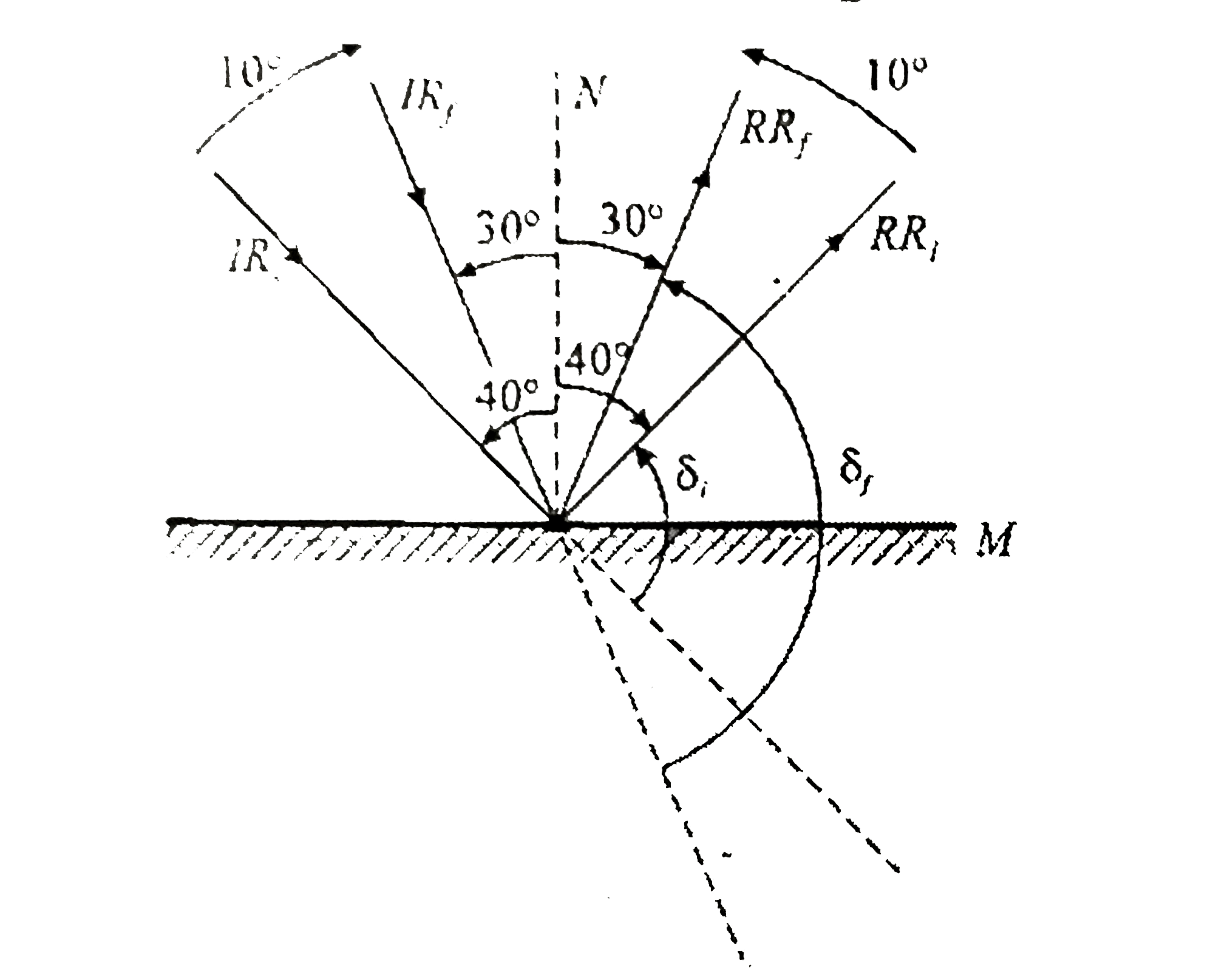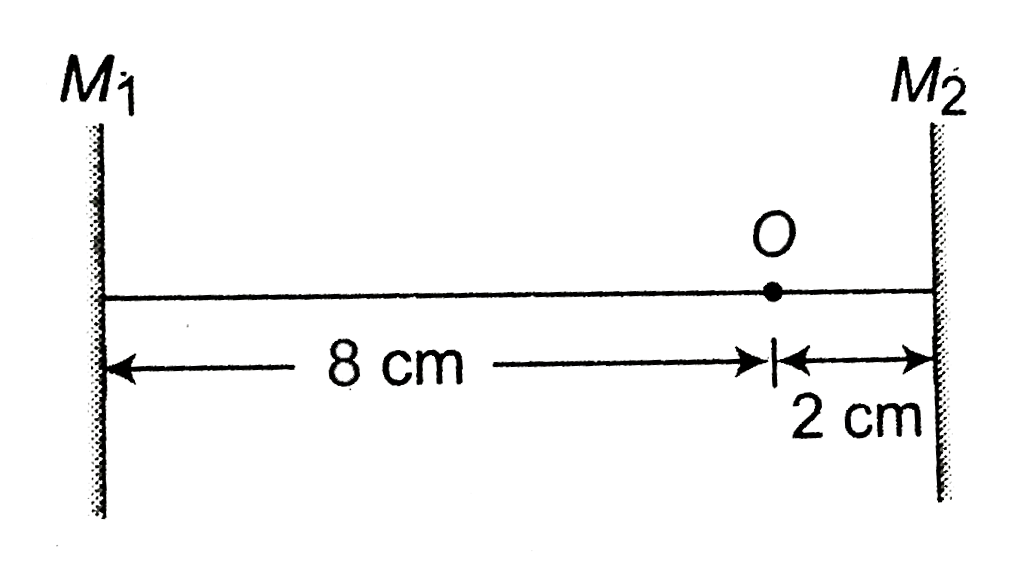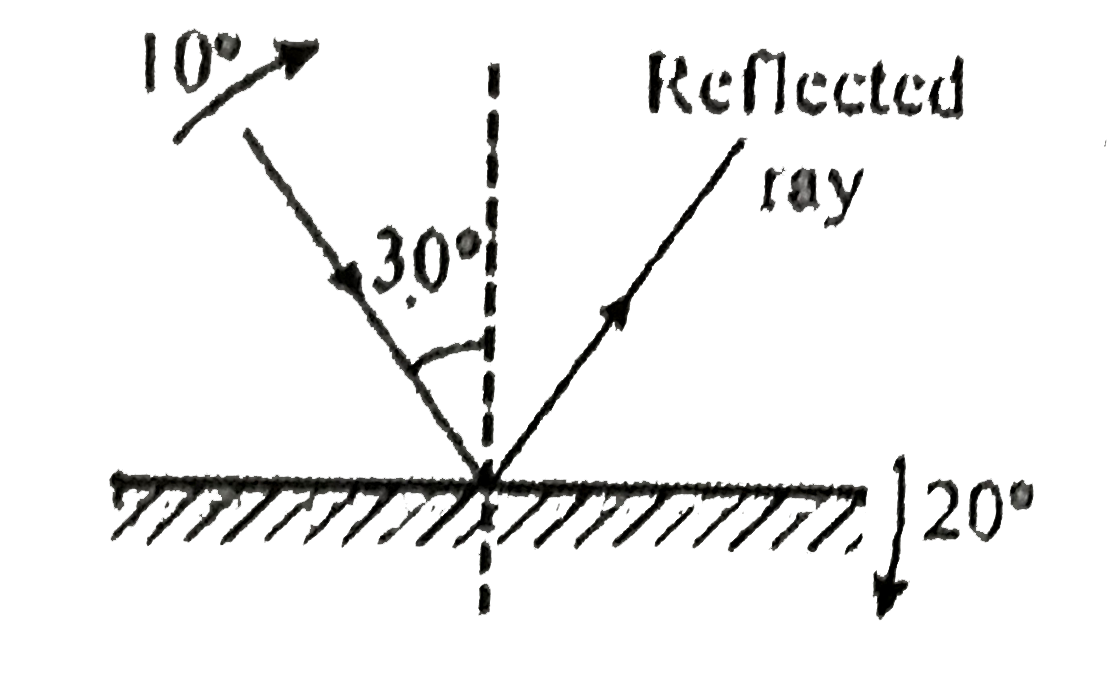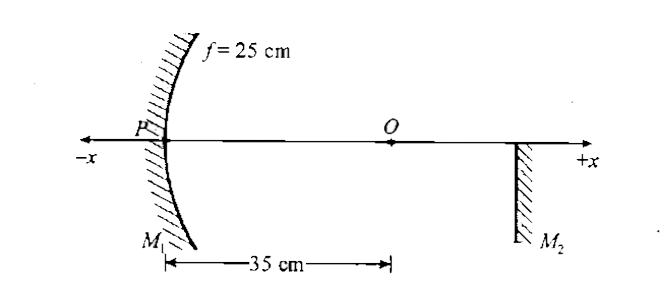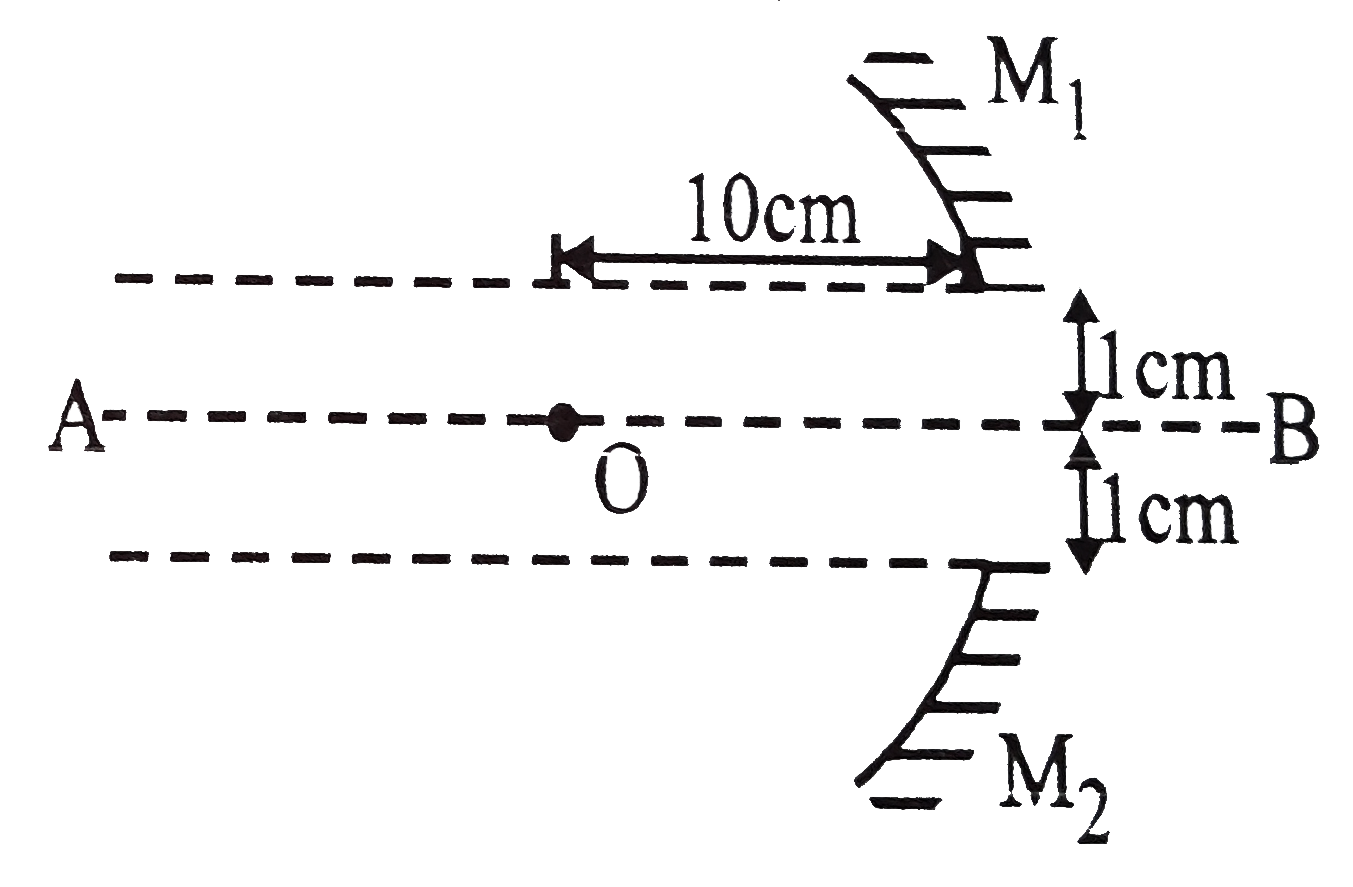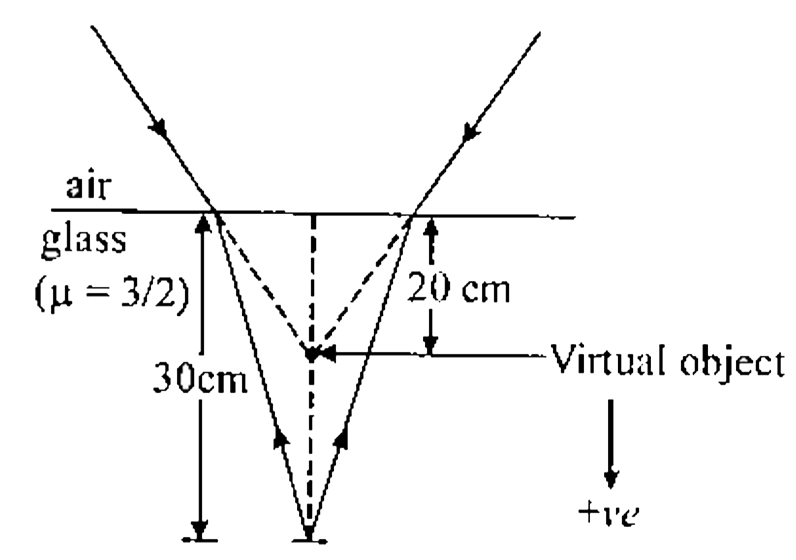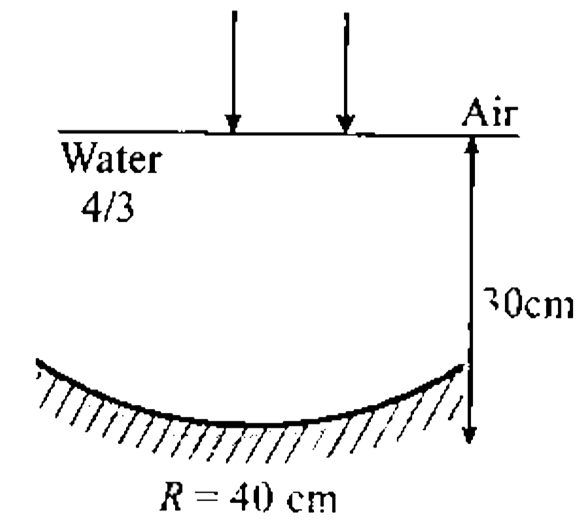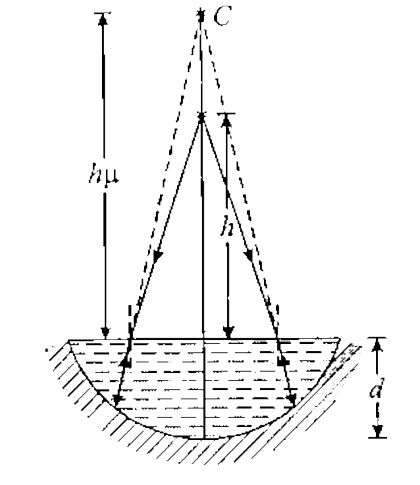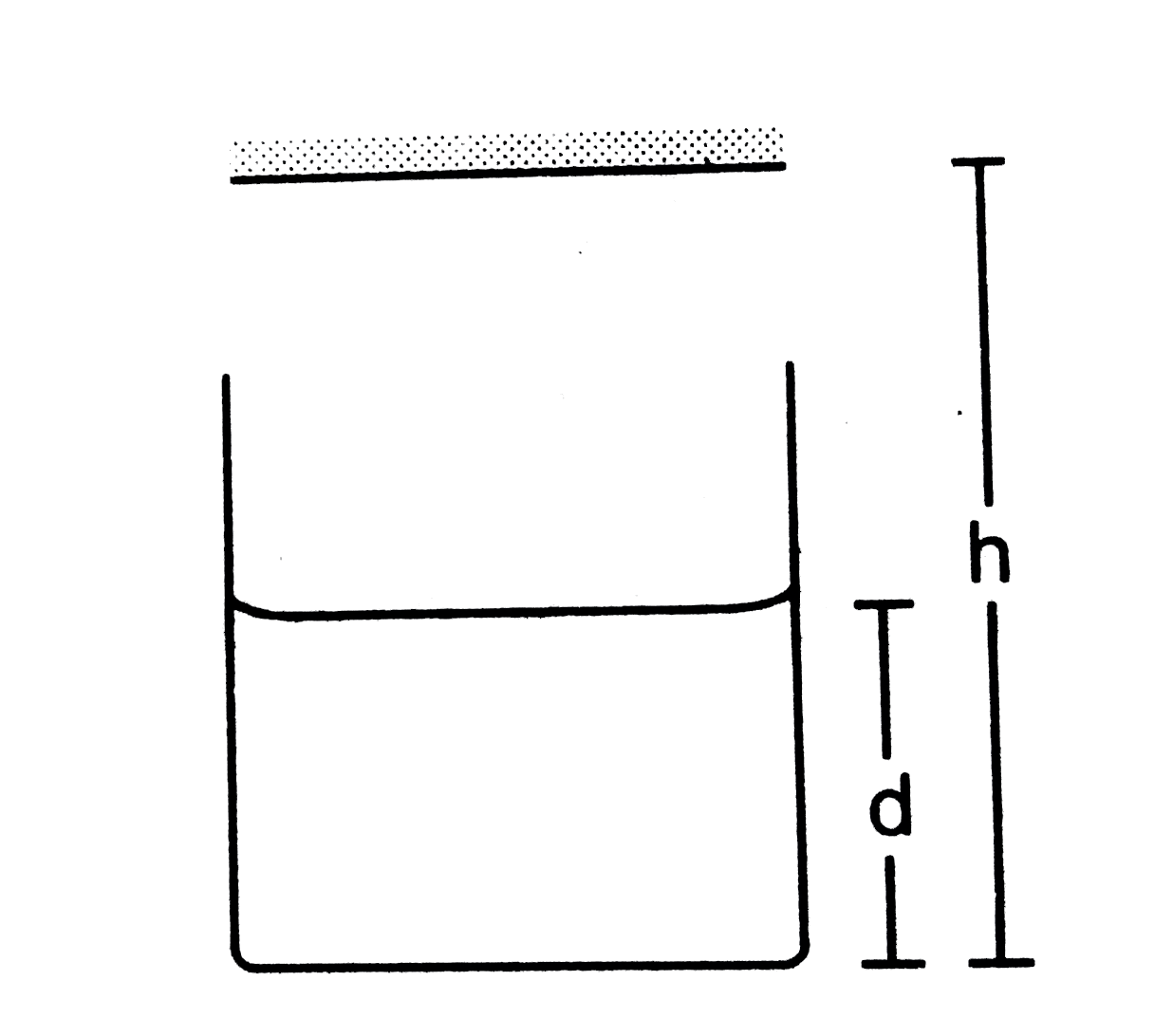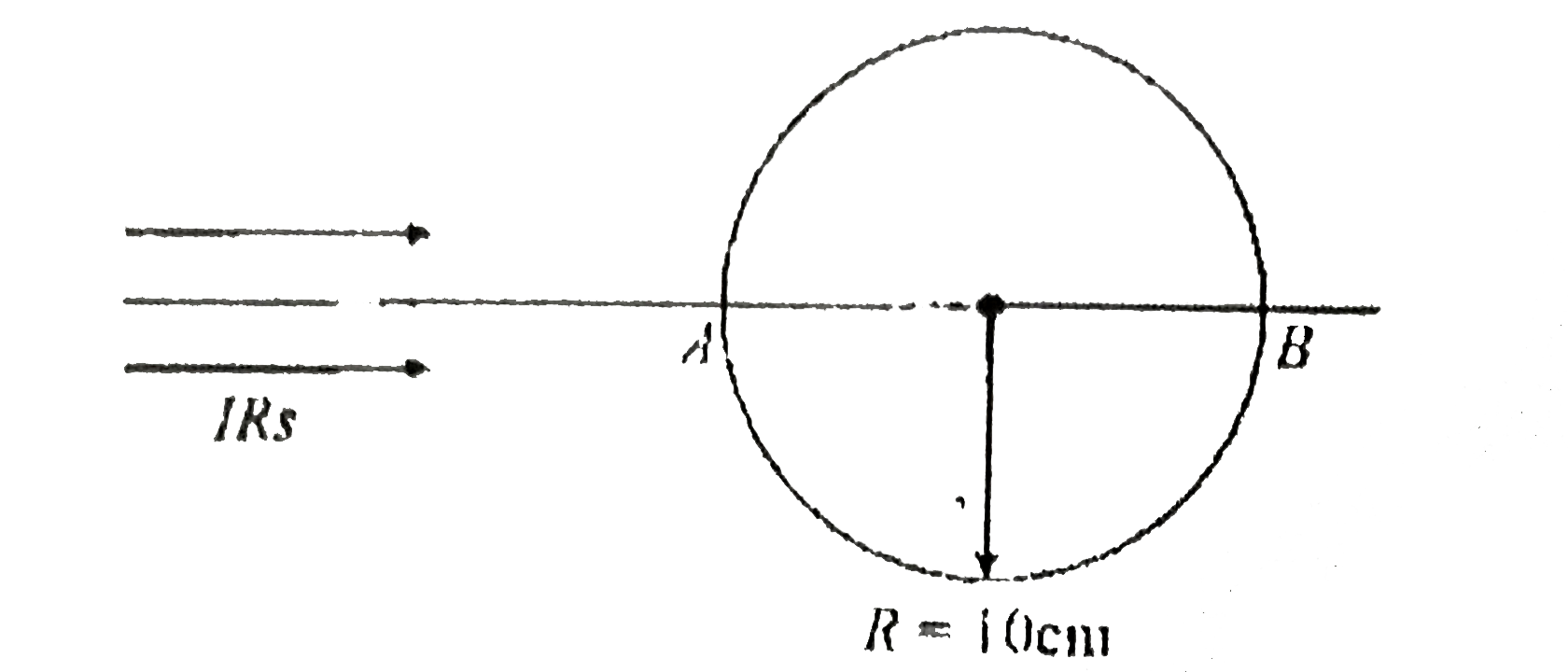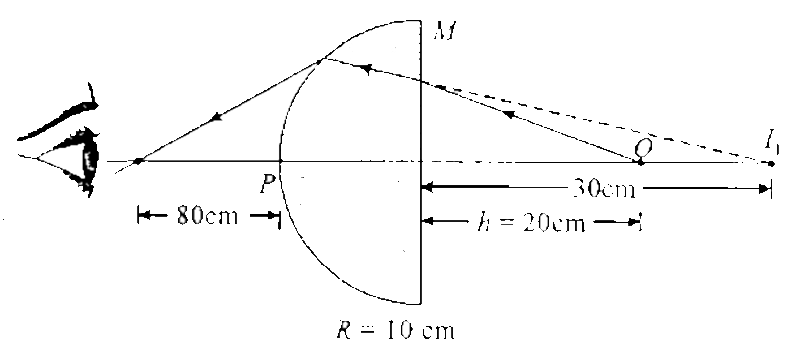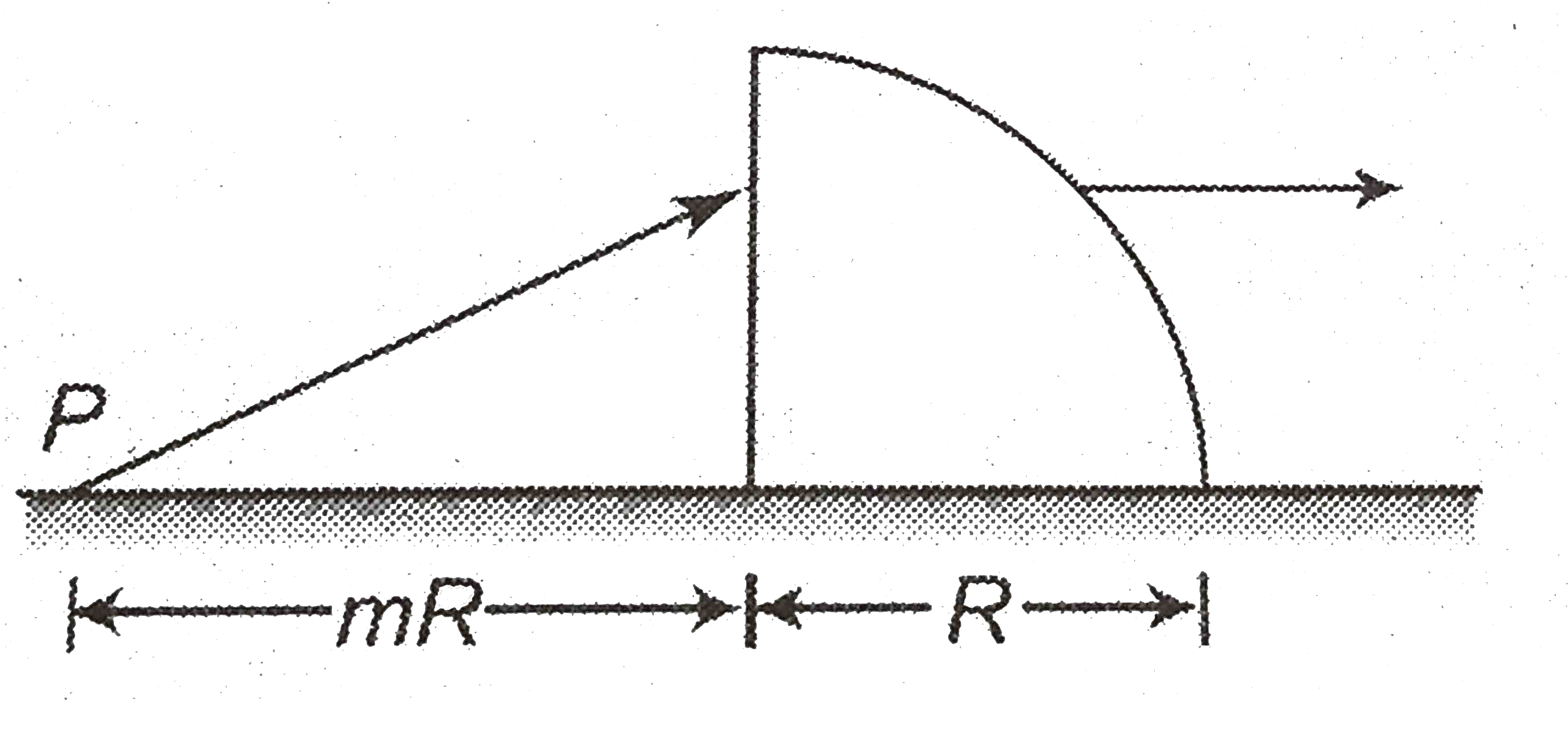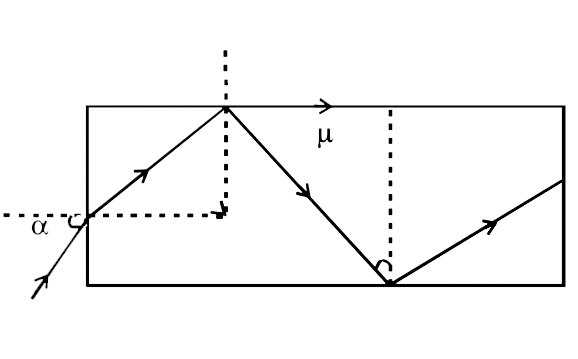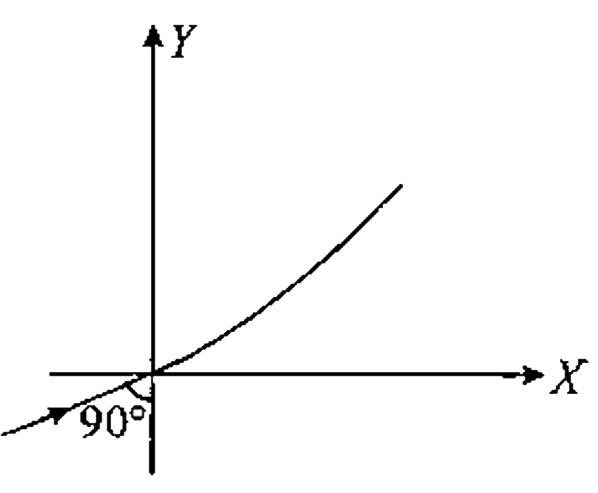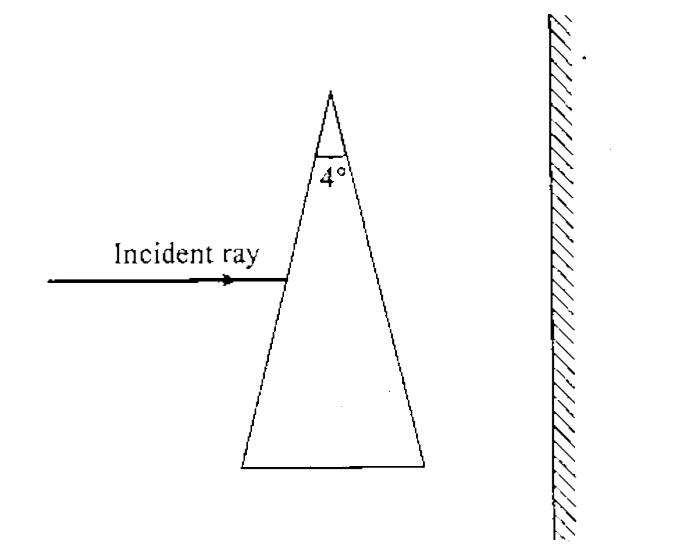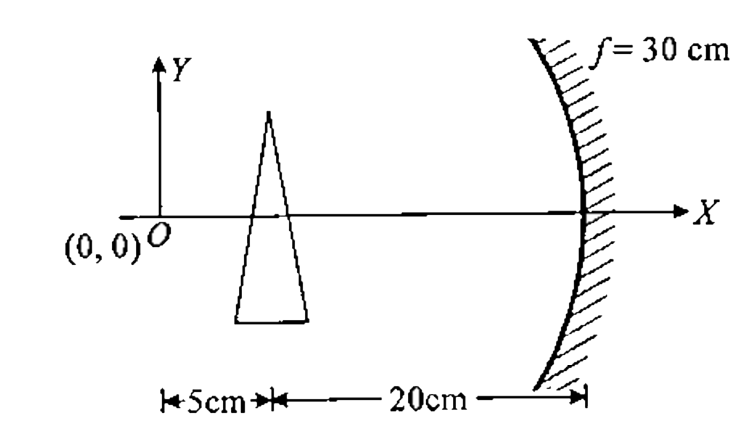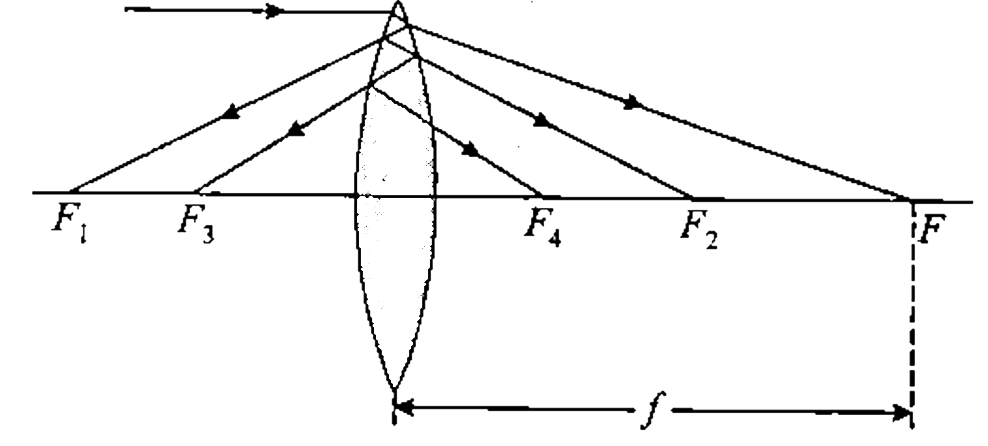Illustrative Example from GK PUBLICATIONS PHYSICS Chapter 6 GEOMETRICAL OPTICS for Class 12
| Class 12 | PHYSICS |
| Chapter | GEOMETRICAL OPTICS |
| GK PUBLICATIONS PHYSICS | Illustrative Example |
| Medium | English |
| Academic Year | 2023-2024 |
Question 2
Two plane mirrors are combined to each other as such one is in (y-z) plane and other is in (x-z)plane.A ray of light along vector 1√3ˆi+1√3ˆj+1√3ˆk is incident on the first mirror. Find the unit vector in the direction of emergence ray after successive reflections through these mirros. View SolutionQuestion 9
Figure shows a torch producing a straight light beam falling on a plane mirror at an angle 60∘ The reflected beam makes a spot P on the screen along y-axis . If at t=0, mirror starts ratating about the hinge A with an angular velocity (ω)=1∘ per second clockwise. Find the speed of the spot on screen after time t = 15 s.
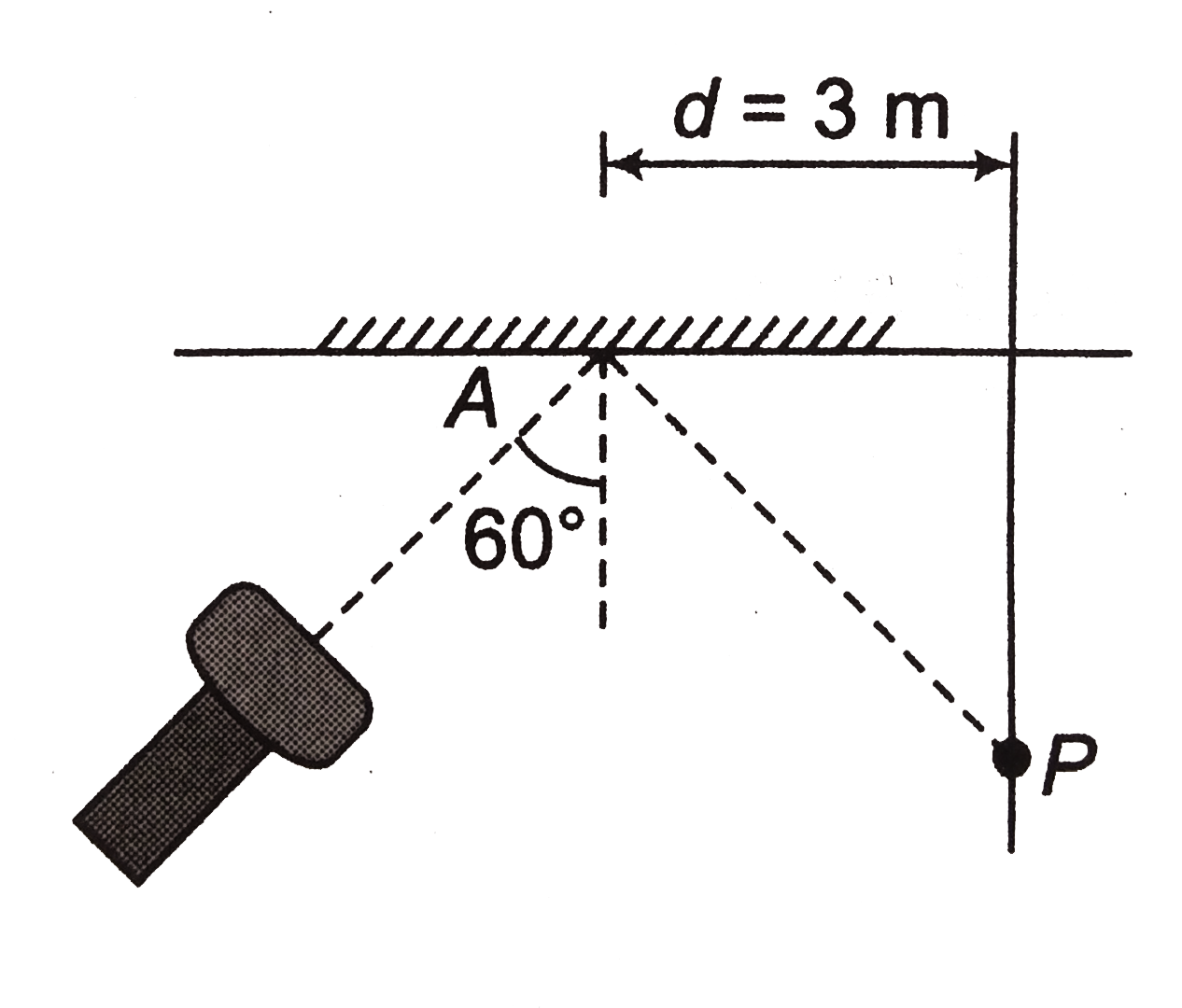 View Solution
View SolutionQuestion 15
An object is placed in front of a convex mirror at a distance of 50cm. A plane mirror is introduced covering the lower half of the convex mirror. If the distance between the object and the plane mirror is 30cm, it is found that there is no parallax between the images formed by the two mirrors. What is the radius of curvature of the convex mirror? View SolutionQuestion 17
A concave and a convex mirror each 30 cm in radius are placed opposite to each other 60 cm apart on the same axis. An object 5cm in height is placed midway between them. Find the position and size of the image formed by two successive reflections, consider first reflection at convex and then at the concave mirror. View SolutionQuestion 18
A thief is running away in a car with velocity of 20m/s. A police jeep is following him, which is sighted by thief in his rear view mirror, which is a convex mirror of focal length 10 m. He observes that the image of jeep is moving towards him with a velocity of 1cm/s. if the magnification of mirror for the jeep at that time is 110. Find
(a) the actual speed of jeep,
(b) rate at which magnification is changing.
Assume the police's jeep is on the axis of the mirror.View SolutionQuestion 19
A Convex mirror of radius of curvature R is fixed on a standat rest with total mass m which is facing a block of equal mass m as shown in figure and is kept on a frictionless horizontal surfece. The separation between the block and mirror is 2R and block is moving at a speed v toward the mirror. Consider elastic collision between block and stand, find the speed of image after time 3R/v.
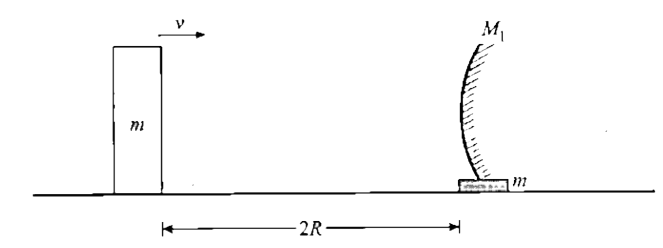 View Solution
View SolutionQuestion 21
An object is located at a distance 30cm on principal axis from the pole of a concave mirror of focal length 20cm. Suddenly the mirror is displaced by a distance 1.5 cm in the direction normal to its principal axis. Calculate the displacement of image produced by the mirror due to this.View SolutionQuestion 24
A bird in air is dividing vertically over a tank with speed 6cm/s. The base of the tank is silvered. The fish in the tank is rising upward along the same line with speed 4cm/s. (Take: μwater=4/3). Find:
(a) The speed of the image of the fish asseen directly by the bird.
(b) The speed of the image of the bird relative to the fish looking upwards. View SolutionQuestion 26
The XY plane is the boundary between two tranparednt media. Medium 1 with z≥0 has a refraxtive index of √2 and medium 2 with z≤0 has a refractive index of √3. A ray of light in medium 1 given by the vector 6√3ˆi+8√3ˆj−10ˆk is incident on teh plane of separation. Find the unit vector in the direction of teh refracted ray in medium 2. View SolutionQuestion 28
A rectangular glass block of thickness 10 cm and refractive index 1.5 placed over a small coin. A beaker is filled with water of refractive index 4/3 to a height of 10 cm and is placed over the glass block.
(a) Find the apparent position of the object when it is viewed at near normal incidence.
(b) if the eye is slowly moves away from the normal at a certain position, the object is found to disappear, due to total internal reflection. At what surface does this happen and why ? View SolutionQuestion 30
A concave mirror has the form of a hemisphere with a radius of R=60cm A thin layer of an unknown transparent liquid is poured into the mirror ,The mirror-liquids system forms one real Image and another real image is formed by mirror alone ,with the sources in a certain position .One of them coincides with the source and the other is at distance of l=30cm from source.find the possible value(s) refractive index μof the liquid.View SolutionQuestion 32
A person looking through a telescope T just sees the points on the rim at the bottom of a cylindrical vessel when the vessel is empty. When the vessel is completely filled with a liquid (μ,=1.5), he observes a mark at the centre B,of the bottom without moving the telescope or the vessel. What is the height of the vessel if the diameter of it scross section is 10cm. View SolutionQuestion 34
A light ray from air is incident on a glass plate of thickness t and refractive index μat an angle of incidence equal to the angle of total internal reflection of glass. Compute the displacement of the ray due to this plate in terms of thickness and refractive index of glass μ. View SolutionQuestion 35
A concave mirror of radius 40 cm lies on a horizontla tale and wateis filled in it up t a heightof 5.00 cm. A small dust particle floats on the water surface at a point P vertically above tge pointof contact of the miror with the table. Locate the image of the dust particle as seen from a point directly above it. tEh refractie index of water is 1.33.
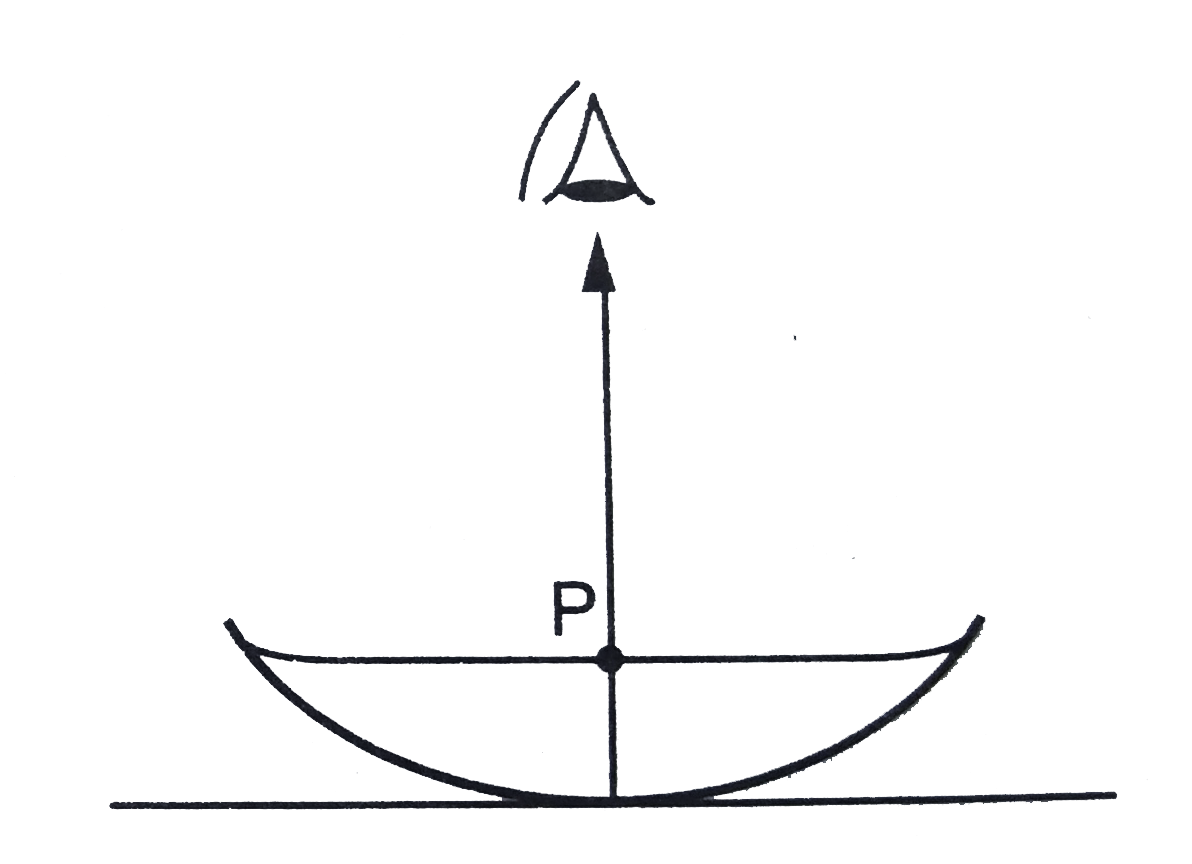 View Solution
View SolutionQuestion 39
A parallel beam of light travelling in water (refractive index =4/3) is refracted by a spherical air bublle of radius 2mm situated in water. Assuming the light rays to be paraxial,
a. Find the position of image due to refraction at first surface and position of the final image.
b. Draw a ray diagram showing the position of both images. View SolutionQuestion 41
A long cylindrical tube containing water in closed by an equinvex lens of local length 10 cm in air. A point source is placed along the axis of the tube outside it at a distance of 21 cm from the lens. Locate the final image of the source. Refractive index of the materials of the lens =1.5 and that of water =1.33.View SolutionQuestion 42
A cylindrical glass rod of radius 0.1m and refractive index √3 lies on horizontal plane mirror. A horizontal ray of light moving perpendicular to the axis of the rod is incident on it. At what height from the mirror should the ray be incident so that it leaves the rod at a height of 0.1m above the plane mirror ? At what distance a second similar rod, parallel to the first, be placed on the mirror, such that the emergent ray from the second rod is in line with the incident ray on the first rod ? View SolutionQuestion 47
A rod made of glass (μ=1.5) and of square cross-section is equal is bent into the shape shown in figure. A parallel beam of light falls perpendicurly on the plane flat surface . A . Referring to the diagram, d is the width of a side & R is radius of inner semicircle. find the maximum value of ratio dR so that all light entering the glass through surface A emerge from the glass through surface B.
_E01_133_Q01.png) View Solution
View SolutionQuestion 53
A right angles prism (45∘,90∘,45∘) of refractive index n has a plate of refractive index (n1<n) cemented to its diagonal face. The assembley is in air. A ray is incident on AB.
a. Calculate the angle of incidence at AB for which the ray strikes the diagonal face at the critical angle.
b. Assuming n=1.351, calculate the angle of incidence at AB for which the refracted rey passes through the diagonal face undeviated.
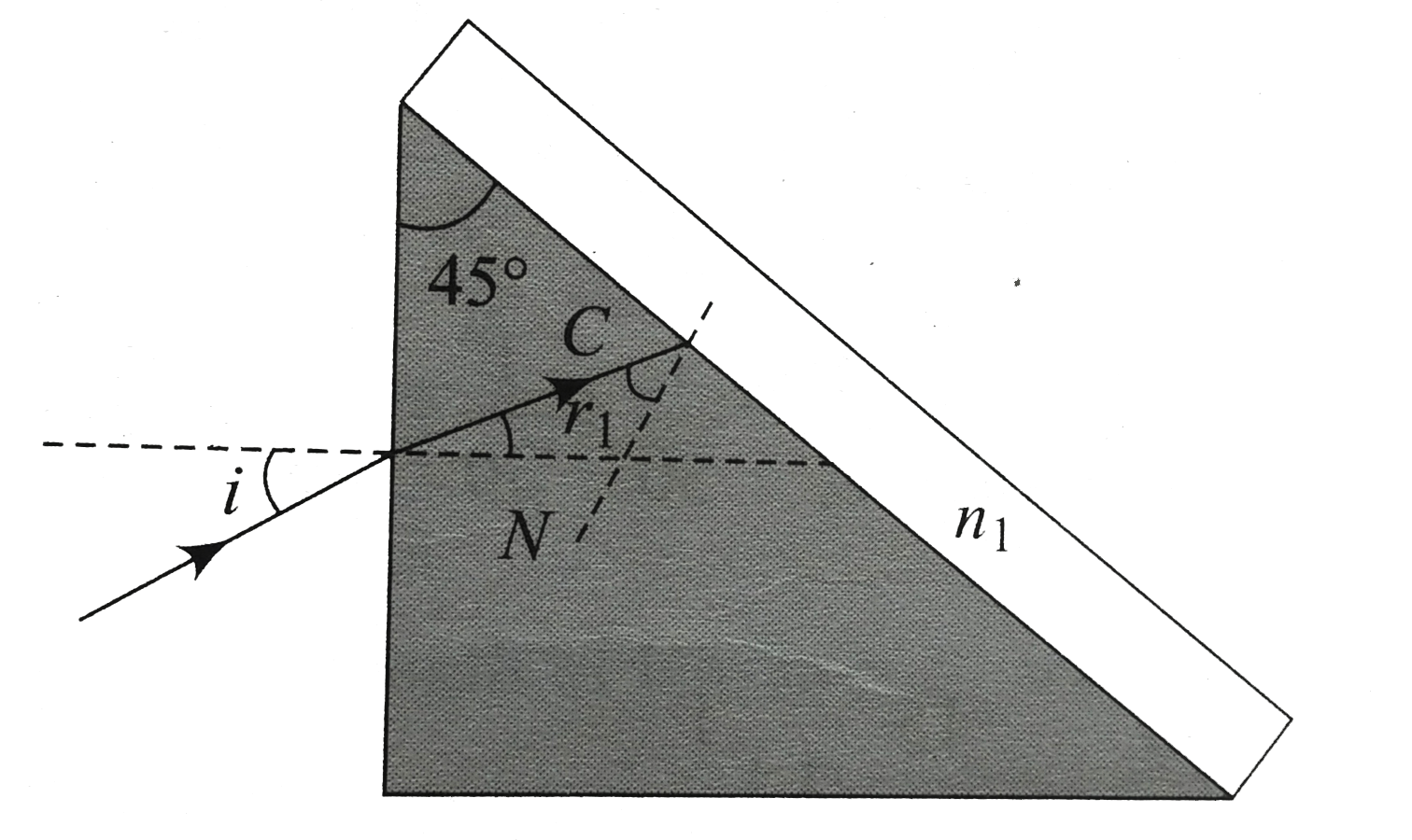 View Solution
View SolutionQuestion 54
In figure, light refracts from material 1 into a thin layer of material 2, crosses that layer, and then is incident at the critical angle on the interface between materials 2 and 3.
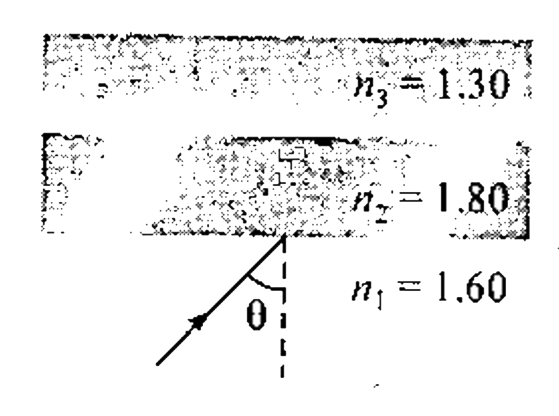
(a) What is the angle θ?
(b) If θ is decreased, is there refraction of light into material 3 ? View SolutionQuestion 56
A monochromatic light is incident on the plane interface AB between two media of refractive indices μ1 and (μ2>μ1) at an angle of incidence θ as shown in Fig.
The angle θ is infinitesimally greater than the critical angle for the two media so that total internal reflection takes place. Now, if a transparent slab DEFG of uniform thickness and of refractive index μ3 is introduced on the interface (as shown in the figure), show that for any value of μ3 all light will ultimately be reflected back into medium II.
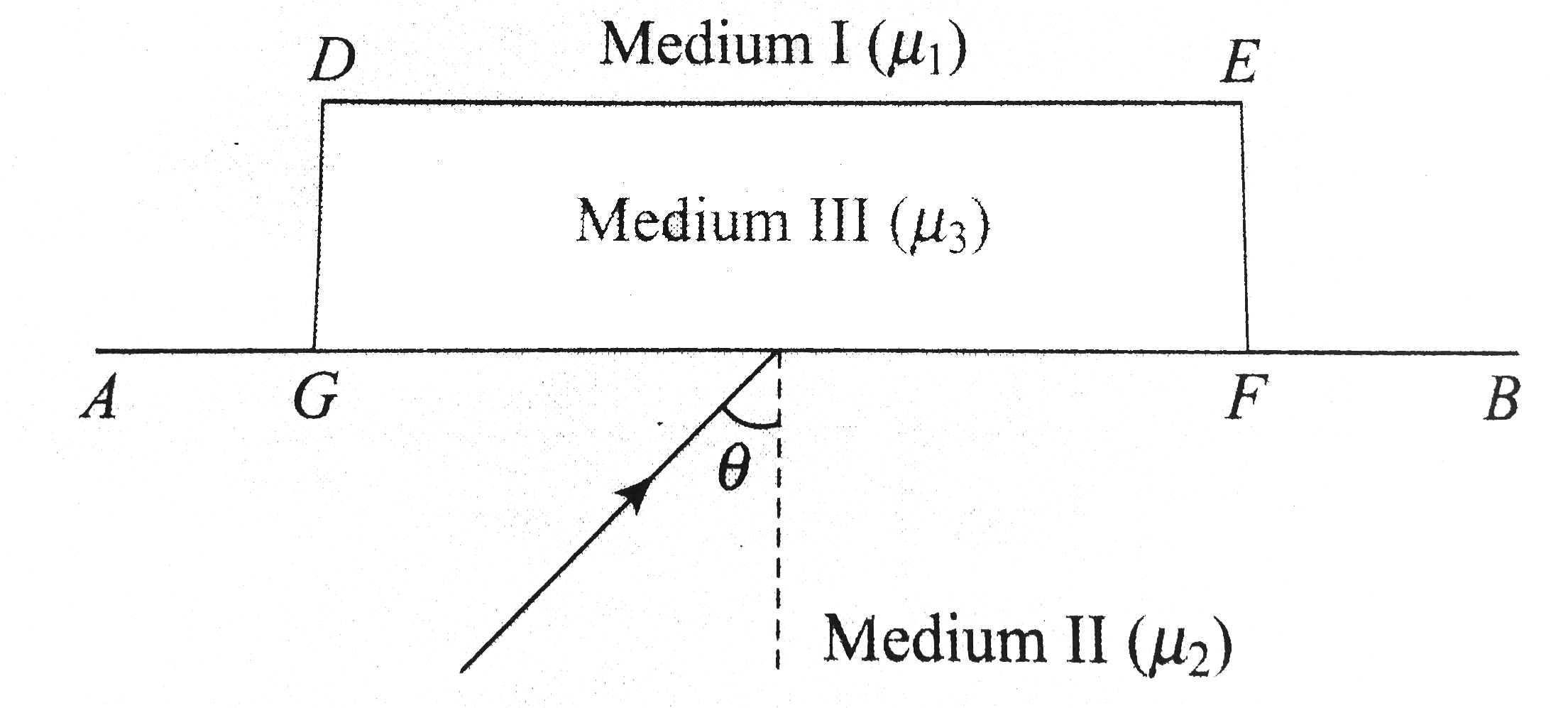 View Solution
View SolutionQuestion 58
Focal length of a thin lens in air, is 10 cm. Now medium on one side of the lens is replaced by a medium of refractive index μ=2. The radius of curvature of surface of leng, in contact with the medium, is 20 cm. Find the point on principal axis where parallel rays incident on lens from air parallel to axis will converge.
 View Solution
View SolutionQuestion 62
A convex lens is held 45cm above the bottom of an empty tank. The image of a point at the bottom of a tank is formed 36cm above the lens. Now, a liquid is poured into the tank to a depth of 40cm. It is found that the distance of the image of the same point on the bottom of the tank is 48cm above the lens. Find the refractive index of the liquid.View SolutionQuestion 63
An object of height 4 cm is kept to the left of and on the axis of a converging lens offocal length 10cm at a distance of 15cm from lens. A plane mirror is placed inclined at 45∘ to the lens axis, 10 cm to the right of the lens.Find the position and size of the image formed by the lens and mirror combination. Trace the path ofthe rays forming the image. View SolutionQuestion 64
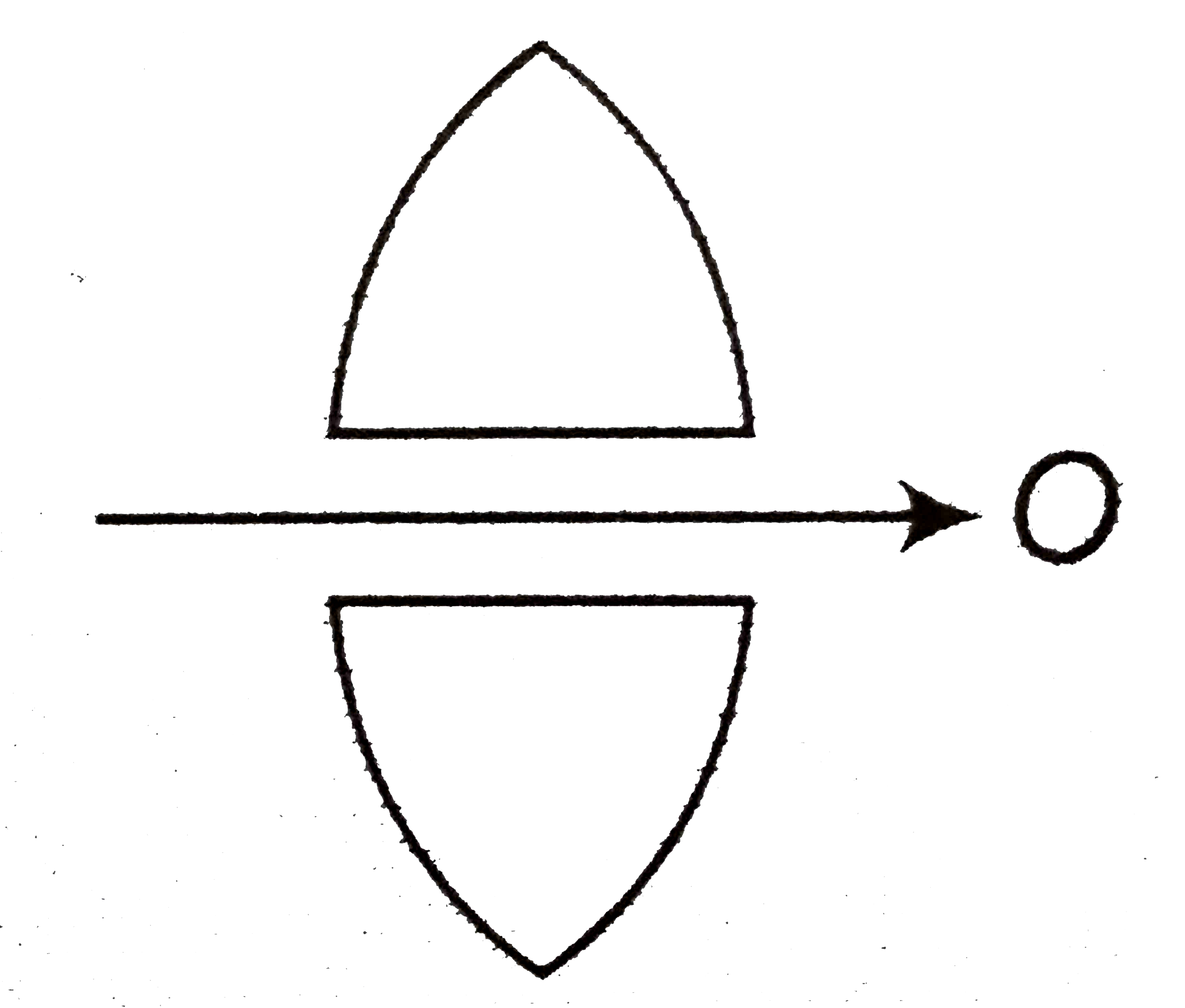
A point object is placed at a distance of 0.3 m from a convex lens (focal length 0.2 m) cut into two halves each of which is displaced by 0.0005 m as shown in the figure. Find the position of the image . If more than one image is formed find their number and the distance between them.View SolutionQuestion 65
A thin converging lens with focal length f=25cm projects the image of an object on a screen removed from the lens by a distance l==5.0m. Then the screen was draws closer to the lens by a distance Δl=18cm. By what distance should the object be shifted for its image to become sharp again ?View SolutionQuestion 66
Determine the position of the image produced by an optical system consisting of a concave mirror with a focal length of 10cm and a convergent lens with a focal length of 20cm. The distance from the mirror to the lens is 30cm and from the lens to the object is 40cm. Consider only two steps. Plot the image.View SolutionQuestion 68
A small fish, 0.4m below the surface of a lake, is viewed through a simple converging lens of focal length 3m. The lens in kept at 0.2m above the water surface such that the fish lies on the optical axis of the lens. Find the image of the fish seen by the observer. The refractive index of water is 4/3. View SolutionQuestion 69
A point object is placed at a distance of 15 cm from a convex lens. The image is formed on the other side of lens at a distance 30 cm from lens. When a concave lens is placed in contact with convex lens, image is shifted away further by 30 cm. calculate the focal lengths of the two lenses.View SolutionQuestion 70
The figure below shows a thin plano-convex lens of refractive index μ1 and a thin plano-concave lens of refractive index μ2, both having same radius of curvature R of their curved surfaces. Another thin lens of refractive index μ3 has same radius of curvature R on the two surface between the plano-convex and plano-concae lenses that the plane surfaces are parallel to each other. Find the focal length of the combination.
 View Solution
View SolutionQuestion 71
The convex surface of a thin concave-convex lens of glass of refractive index 1.5 has a radius of curvature 20 cm. The concave surface has a radius of curvature 60 cm. The convex side is silvered and placed on a horizontal surface as shown in figure. (a) Where should a pin be placed on the axis so that its image is formed at the same place ? (b) If the concave part is filled with water (mu = 4/3), find the distance through which the pin should be moved so that the image of the pin again coincides with the pin.
 View Solution
View SolutionQuestion 72
The radius of curvature of the curved surfaces of an equiconvex lens is 32 cm and its refractive index is μ=1.5. One of its side is silvered and placed 14 c away from an object as shown in figure. At what distance x should a second convex lens of focal length 24 cm be placed so that the image coincides with the object.
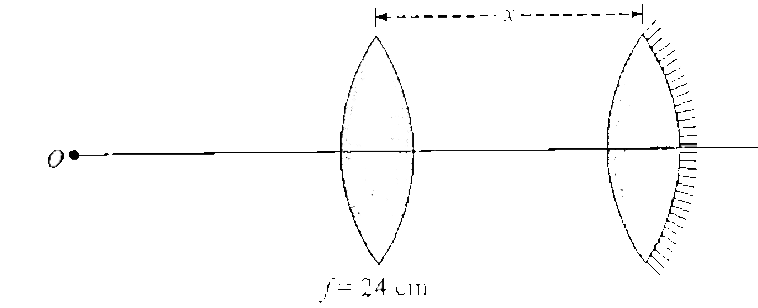 View Solution
View SolutionQuestion 73
A point source of light is placed inside water and a thin converging lens ofrefractive index μ2 is placed just outside the plane surface of water. The image of the source is formed at a distance x from the surface of water. If the lens is now placed just inside water and the image is now formed at a distances' from the surface of water, show that
1x−1x1=μ1−1μ2−1×1f,
Where f is the focal length of the lens and μ1 is the refractive index of water.View SolutionQuestion 74
A thin plano-convex lens of focal length f is split into two halves. One of the halves is shifted along the optical axis as shown in figure. The separation between object and image planes is 1.8 m. The magnification of the image, formed by one of the ball lens is 2. Find the focal length of the lens and separation between the two halves. Draw the ray diagram for image formation.
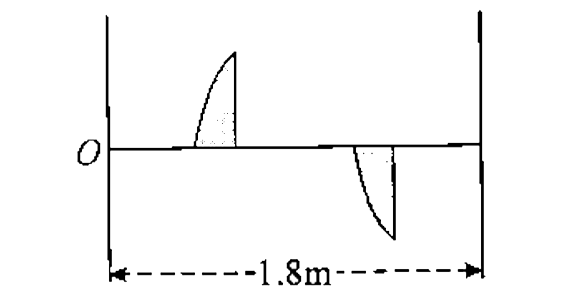 View Solution
View SolutionQuestion 75
A thin converging lens is placed between an object and a screen whose position are fixed. There are two positions of the lens at which the sharp image of the object is formed on the screen. Find the transverse dimension of the object if at one position of the lens the image dimension equal h'=2.0mm and at the other, h''=4.5mm.View SolutionQuestion 76
A thin equiconvex lens of glass of refractive index μ=3/2 & of focal length 0.3min air is sealed into an opening at one end of a tank filled with water (μ=4/3) .On the opposite side of the lens ,a mirror is placed inside the tank on the tank wall perpendicular to the lens axis ,as shown in figure .the separation between the lens and the mirror is 0.8mA small object is placed outside the tank in front of the lens at a distance of 0.9m form the lens along its axis .Find the position (relative to the lens)of the image of the object fromed by the stsyem.
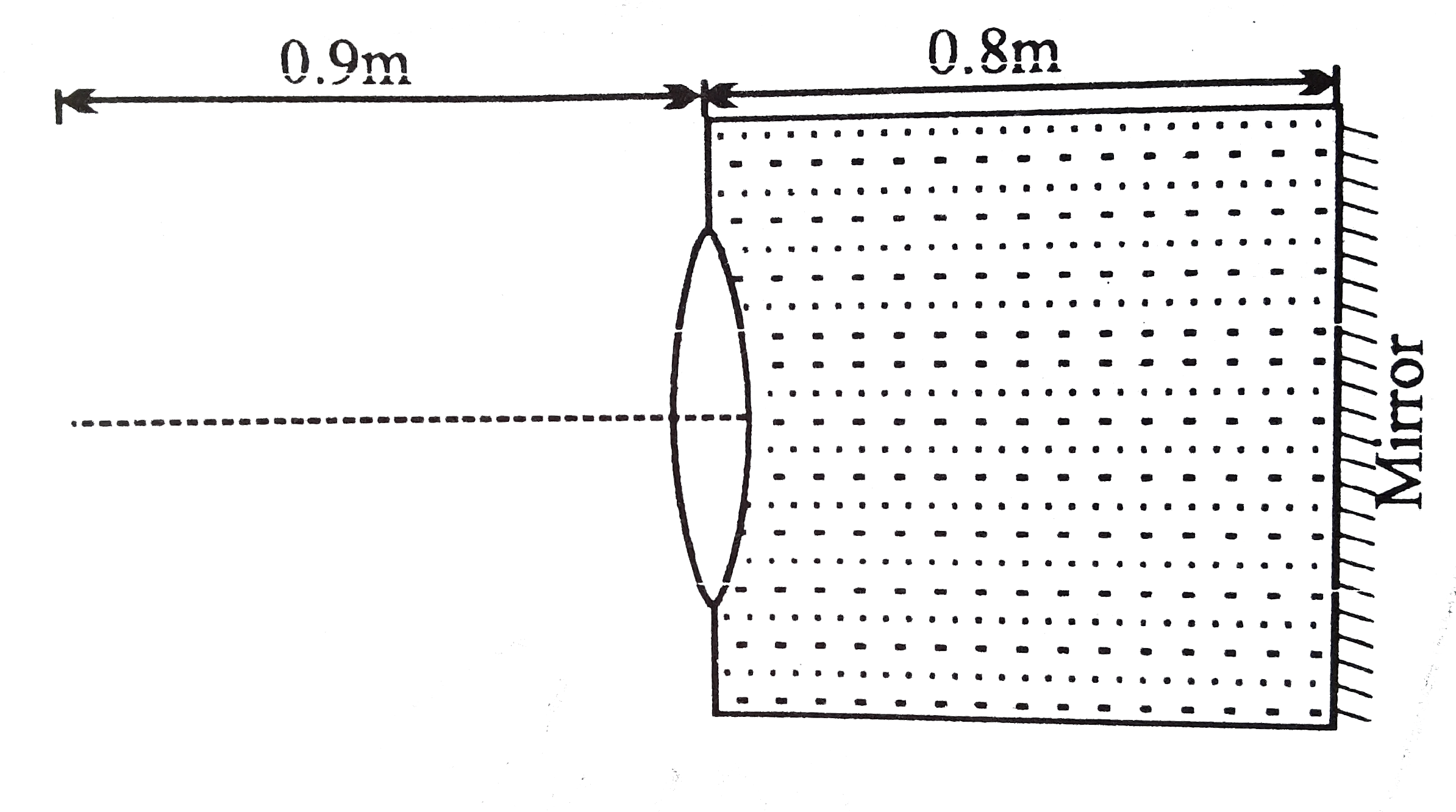 View Solution
View SolutionQuestion 77
Bottom of a glass beaker is made of a thin equi-convex lens having bottom side silver polished as shown in the figure. Water is filled in the beaker upto a height 4m. The image of poin to bject,floating at middle point of beaker at the surface of water coincides with it. Find out ther adius of curvature of the lens.Given that refractive index of glass is 3/2 and that of water is 4/3.
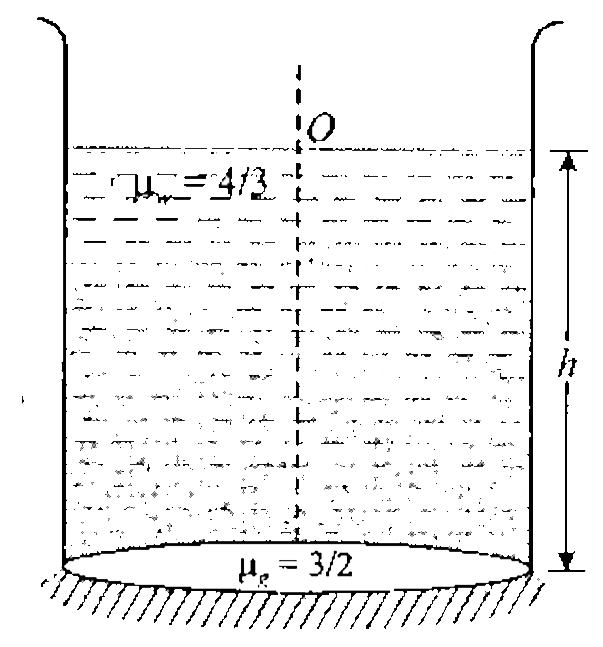 View Solution
View SolutionQuestion 81
A thin biconvex lens is placed with its principal axis first along a beam of parallel red light and then along a beam of parallel blue light. If the refractive indices of the lens for red and blue light are respectively 1.514 and 1.524 and if the radius of curvature of the faces are 30 cm and 20 cm, calculate the sepration of for red and blue light. If the focal length for the mean colour (yellow) is 23.1 cm, find the dispersive power of the material of the lens.View SolutionQuestion 82
Two parallel beams of light P and Q (separation d) containing radiation of wavelengths 4000A and 5000A (which are mutually coherent in each wavelength separately) are incident normally on a prism as shown in fig. The refractive index of the prism as a function of wavelength is given by the relation. μ(λ)=1.20+bλ2 Where λ is in A and b is positive constant. The value of b is such that the condition wave length and is not satisfied for the other.
(a) Find the value of b.
(b) find the deviation of the beams transmitted through the face AC. (c) A convergent lens is used to bring these transmitted beams into focus. If the intensities of transmission form the face AC, are 41 and I respectively, find the resultant intensity at the focus.
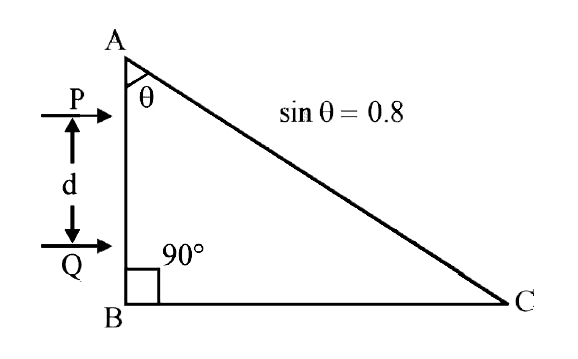 View Solution
View SolutionQuestion 84
The focal lengths of the objective and eyepiece of a microscope are 4mm and 25 mm respectively, and the length of the tube is 16cm. If the final image is formed at infinity and the least distance of distinct vision is 25 cm, then calculate the magnifying power of the microscope. View SolutionQuestion 85
A telescope has an objective of focal length 50cm and an eyepiece of focal length 5cm. The least distance of distinct vision is 25cm. The telescope is focused for distinct vision on a scale 2m away from the objective. Calculate (a) magnification produced and (b) separation between objective and eyepiece. View SolutionQuestion 86
A compound microscope is used to enlarge an object kept at a distance 0.03m from cuts objective which consists of serval convex lenses in contact and has focal length 0.03m. If a lens focal length 0.1mis removed from the objective, find out the distance by which the eye-piece of the microscope must be moved to refocus the image.View Solution
All Exercises from GK PUBLICATIONS PHYSICS Class 12 PHYSICS GEOMETRICAL OPTICS
- Advance MCQs with One or More Options Correct
- Conceptual MCQs Single Option Correct
- Discussion Question
- Illustrative Example
- Numerical MCQs Single Options Correct
- Practive Exercise 5.1
- Practive Exercise 5.2
- Practive Exercise 5.3
- Practive Exercise 5.4
- Practive Exercise 5.5
- Practive Exercise 5.6
- Practive Exercise 5.7
- Practive Exercise 5.8
- Practive Exercise 5.9
- Unsolved Numerical Problems
